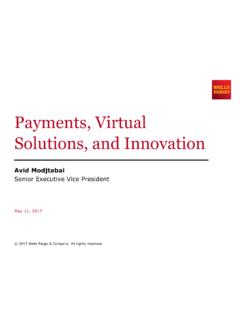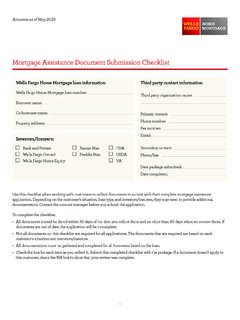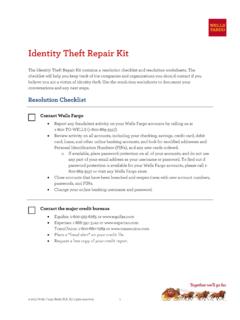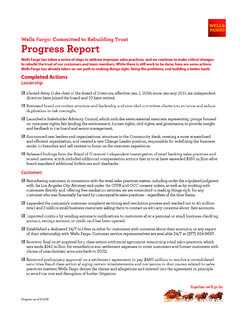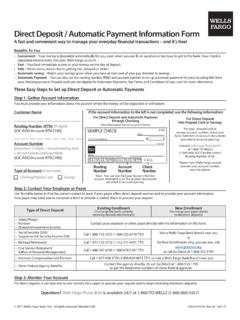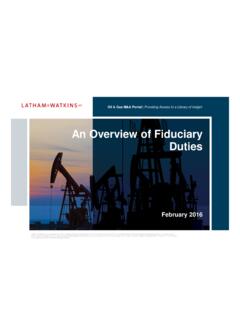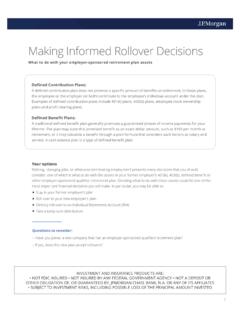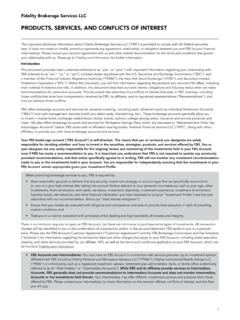Transcription of How to correct excess IRA contributions - Wells Fargo
1 How to correct excess IRA contributions You may discover that you contributed amounts to your Traditional or Roth IRA in excess of the allowable limits. What can you do? Fortunately, the Internal Revenue Code (IRC) allows these excess amounts to be corrected without penalty, provided the correction occurs within a certain time frame. How can an excess contribution happen? 1. Timely remove excess before the tax filing deadline The excess or unwanted IRA contribution amount, An excess contribution is generally one that exceeds the plus the net gain or loss, will need to be removed by the tax IRA contribution limit.
2 An excess contribution can occur filing deadline (generally April 15), including an automatic in an IRA for a variety of reasons including the following: six month extension. This means the excess should Contribution is more than the annual contribution limit generally be distributed by October 15. If you remove the excess contribution after you file your taxes, you may need Contribution is more than your earned income to file an amended tax return. If you remove the excess in Contribution made on behalf of an individual after date a timely manner, you will owe tax and, if under age 59 , of death the IRS 10% additional tax for early or pre-59 distributions Required minimum distribution (RMD) is rolled over (10% additional tax) on any earnings, not on the excess contribution.
3 See the next page for the IRS provided making an ineligible rollover contribution formula for calculating the Net Income Attributable (NIA). Contribution to a Roth IRA and your modified adjusted of either earnings or losses. gross income (MAGI) exceeded the income limit 2. Recharacterization A recharacterization involves Unable to deduct a Traditional IRA contribution; this is transferring the annual contributions from the current IRA. truly not an excess contribution because being unable to to the other type of IRA either Traditional or Roth as deduct does not mean that you weren't able to contribute deemed appropriate.
4 Note, you can't recharacterize more than your allowable maximum contribution. When What is the penalty for not removing recharacterizing an annual contribution, it will be considered the excess contribution? to have been contributed for the same taxable year that the contribution was originally made. The earnings or loss If you do not remove the excess amount by the deadline, attributable to the contribution that is being recharacterized you will owe a 6% IRS excise tax for every year the excess must also be transferred using the NIA formula. remains in the account. 3. Remove excess after the tax filing deadline Only a Ways to correct an excess contribution true excess , not a nondeductible contribution, can be removed after the deadline.
5 You will remove only the There are typically four methods to correct an amount of the excess ; no earnings or loss will be calculated. excess contribution: You will owe the 6% excise tax for every year the excess 1. Timely Remove excess before the tax filing deadline remains in the IRA. Additionally, you may not deduct the excess amount when filing your taxes. The excess amount 2. Recharacterization removed will not be taxable if your aggregate contributions 3. Remove excess after the tax filing deadline for the year do not exceed the annual contribution limit. 4. Carry forward However, if your aggregate contribution limit for the year Investment and Insurance Products: NOT FDIC Insured NO Bank Guarantee MAY Lose Value exceeded the annual amount, then the excess is taxable 4.
6 Carry forward You can offset the excess contribution and would be subject to the 10% additional tax if you are by limiting your annual contribution for the following year under age 59 . For example, you made a $6,000 Roth IRA to the maximum minus the excess , as long as you qualify contribution but only qualified to make a $5,000 to make a contribution. No distribution from your IRA will contribution. The $1,000 excess would not be taxed occur. For example, if your contribution limit is $6,000. and penalized because it wasn't more than the annual and you exceed it by $1,500, you can offset the excess by contribution limit.
7 However, if you made an $8,000 limiting your contributions to $4,500 the following year. contribution but your limit was $7,000 you would have an Remember, if you use the carry forward method, you are excess of $1,000. You would owe the 6% excise tax, subject to the 6% excise tax because you did not correct the ordinary income tax and if under age 59 the 10% excess by the deadline. You will not owe tax and, if you are additional tax on the $1,000 removed. under 59 , the 10% additional tax on any earnings. You will not be able to recharacterize the carry forward amount to the other type of IRA.
8 For example, if the carry forward amount is in a Traditional IRA, you cannot recharacterize that amount as a Roth IRA contribution. How to calculate earnings or losses The IRS provides a specific formula Net Income Attributable (NIA) that must be applied to calculate earnings or losses attributable to an excess contribution. Net Income = excess to be removed x Adjusted Closing Balance (ACB) Adjusted Opening Balance (AOB). Adjusted Opening Balance Here's how to determine the numbers to plug into the NIA formula: To determine the adjusted opening balance, add to the prior month end IRA balance all contributions (including the contribution creating the excess ), consolidations, and transfers into the account since the contribution occurred.
9 To determine the adjusted closing balance, subtract from the current value of the IRA all distributions, consolidations, and transfers in since the contribution occurred. excess contribution hypothetical examples Timely removal of excess plus earnings hypothetical Linda, age 48, contributed $7,000 to her IRA last year. When filing taxes, she discovers she was eligible to contribute only $6,000. She requests to remove the $1,000 excess . Her IRA balance prior to the contribution was $22,000 and is now worth $31,750. She made no additional contributions or distributions. Her ACB is $31,750 and her AOB is $29,000.
10 ($22,000 + $7,000). Linda will remove the $1, ($1000 excess contribution + $ earnings attributable to the excess contribution). $1,000 x ($31,750 - 29,000) $1,000 x $2,750. = = $ NIA = $ earnings $29,000 $29,000. Timely removal of excess minus earnings hypothetical Zeke, age 62, contributed $7,000 to his IRA last year. When filing taxes, he discovers that due to his amount of earned income, he was only eligible to contribute $4,500. He requests to remove the $2,500 excess . His IRA balance prior to the contribution was $260,000 and is now worth $250,675. He made no additional contributions or distributions.
